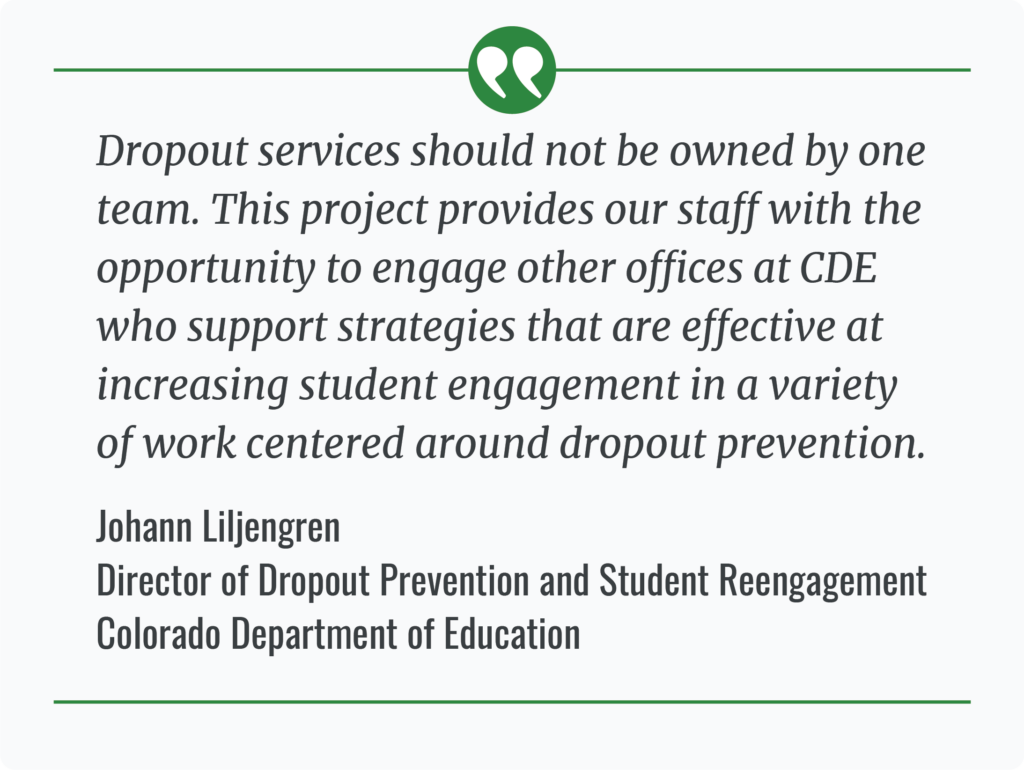Voices from the Field spotlights stakeholders in Region 12 and their work to improve educational opportunities and outcomes. R12CC is privileged to collaborate with and share the insights of Johann Liljengren, Director of Dropout Prevention and Student Reengagement at the Colorado Department of Education (CDE).
 The Dropout Prevention Framework is receiving an update since it was first published nearly 12 years ago and provided schools and districts with 11 recommended strategies that positively impact dropout prevention. The new framework contains five foundational, high-level systems that provide the groundwork and foundation for students’ connections to school and four prioritized strategies for intervention. Additional tools will accompany the framework including a role specific guide that designates what the implementation of dropout prevention services might look like at the classroom, school, and district levels, research briefs on the strategies, a readiness assessment, and strategy specific implementation stories that offer a glimpse into the practices of Colorado schools that are implementing these strategies and experiencing some success.
The Dropout Prevention Framework is receiving an update since it was first published nearly 12 years ago and provided schools and districts with 11 recommended strategies that positively impact dropout prevention. The new framework contains five foundational, high-level systems that provide the groundwork and foundation for students’ connections to school and four prioritized strategies for intervention. Additional tools will accompany the framework including a role specific guide that designates what the implementation of dropout prevention services might look like at the classroom, school, and district levels, research briefs on the strategies, a readiness assessment, and strategy specific implementation stories that offer a glimpse into the practices of Colorado schools that are implementing these strategies and experiencing some success.
What is your professional role at the Colorado Department of Education and your responsibilities related to the Dropout Prevention Framework Project?
I am the Director of our Dropout Prevention and Student Reengagement Office and I help our team lead work focused on two main goals: to improve statewide graduation rates and decrease statewide dropout rates. Prior to taking this role in 2022, I was a participant in the Dropout Prevention Framework Project for several years. In my role at the Colorado Department of Education (CDE), I came to see the framework as a comprehensive tool to shape and support how we talk about the strategies and interventions that prevent student dropouts as well as reengage students in their education. Updating this framework will bring credibility and expertise to the final product, which will hopefully be more relevant to the current situation in schools.
How does this project complement or impact other initiatives at the Colorado Department of Education?
Dropout services should not be owned by one team. This project provides our staff with the opportunity to engage other offices at CDE who support strategies that are effective at increasing student engagement in a variety of work centered around dropout prevention. The updated framework gives everyone at CDE a specific language that can engage a broader audience. For example, we hope that the school improvement team can talk with districts and make clear connections to dropout prevention, and our standards and instruction team can engage school districts in core strategies that are important for dropout prevention. The updated framework also  supports our work around competitive grants at CDE. As districts are applying for and conducting work funded by those grants, efforts will be more targeted and focused on outcomes that align with research-based practices that improve graduation rates and decrease dropout rates.
supports our work around competitive grants at CDE. As districts are applying for and conducting work funded by those grants, efforts will be more targeted and focused on outcomes that align with research-based practices that improve graduation rates and decrease dropout rates.
What does success look like?
I think success is threefold. First, we want our team in the Dropout Prevention and Student Reengagement Office to be a resource for those in the field when it comes to dropout prevention research and practice. The framework also provides one location where these resources are available and allows users to navigate to the information that applies to their specific situation or context. Next, success is achieved when districts can identify their areas of need related to the framework’s foundational practices and strategies and identify and utilize the appropriate resources to inform their work. Finally, there are school and district leaders in Colorado who are doing work that is connected to dropout prevention even though they might call it something else. A sign of success would be to see the framework used in work across other offices within the Colorado Department of Education who provide services that overlap with dropout prevention. The foundational practices and strategies in the framework are not just for a student who is at risk of dropping out but are relevant interventions for all students.
In what ways has support from the Region 12 Comprehensive Center benefitted the Colorado Department of Education’s priorities related to dropout prevention and student re-engagement?
Region 12 Comprehensive Center provides us with the capacity to engage in updating the Dropout Prevention Framework and the credibility and outside expertise to complete this work. The broad team supports an increase in awareness of the scope of dropout prevention at a national level and will help us develop a better product. One example is the implementation tools we are developing to accompany the framework. Typically, my office wouldn’t have the capacity or experience in developing such tools.
How has the project work changed over time? Is there anything that you would have done differently? What recommendations would you have for someone else beginning a similar project?
I became the Director after the Dropout Prevention Framework Update Project began and had some specific priorities. My goal as the Director is to increase technical assistance and support to the field that is inside and outside of competitive grants. I want the products that accompany the framework to have a purpose and be useful tools for districts and schools.
My recommendation to others working on a similar project is to have a clear vision that aligns with your organizational goals. Communicate that vision clearly so your team can help shape it. If this framework is not useful and connected to our everyday work, I fear it will not get the attention it deserves.
Is there anything else you would like to share?
I am excited about how this framework will shape how we talk about dropout prevention practices by creating a common language. There is so much information out there in the field of dropout prevention and interventions, some of it is very strong, while some is more anecdotal in terms of practices. I see value in how we are compiling and presenting the information to inform practice in the field, with a focus on interventions that will move the needle.
